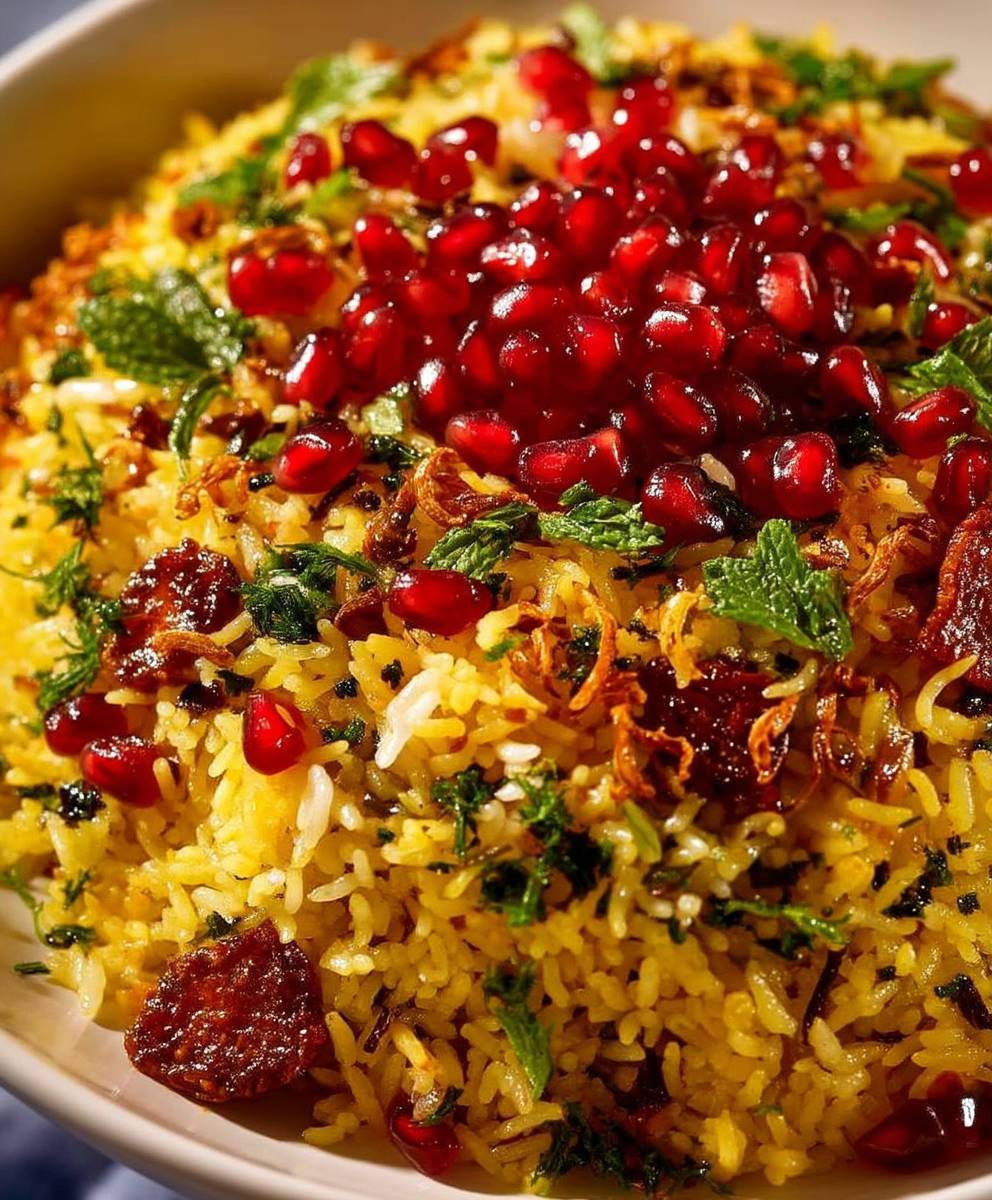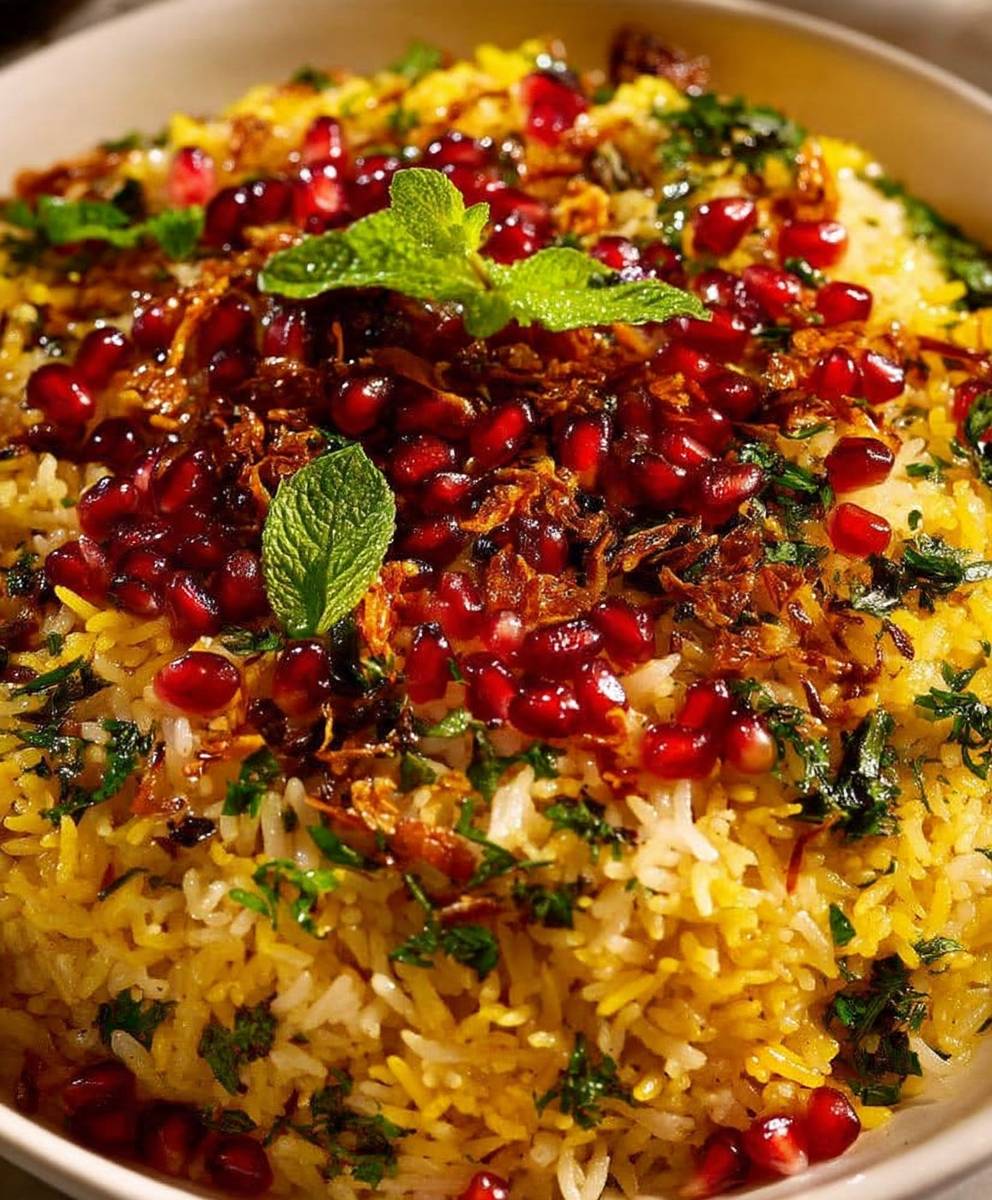Jewelled rice pilaf, a dish as radiant as a spring morning, is the perfect centerpiece for your Easter celebration. Imagine a fluffy bed of basmati rice, studded with glistening dried fruits and crunchy nuts, each bite a burst of flavor and texture. This isn’t just rice; it’s a culinary tapestry woven with sweet, savory, and aromatic threads, guaranteed to impress your guests and elevate your Easter feast.
While variations exist across cultures, jeweled rice, often called “Morassa Polo” in Persian cuisine, has a rich history, traditionally served during special occasions and celebrations. The vibrant colors of the dried fruits cranberries, apricots, and golden raisins symbolize prosperity and good fortune, making it a particularly fitting dish for Easter, a time of renewal and hope. The nuts, like pistachios and almonds, add a delightful crunch and a touch of elegance.
What makes jewelled rice pilaf so beloved? It’s the harmonious blend of flavors and textures. The delicate sweetness of the dried fruits complements the nutty aroma of the rice, while the spices, such as saffron and cardamom, add a warm and inviting fragrance. Beyond its exquisite taste, this dish is surprisingly easy to prepare, making it a stress-free addition to your Easter menu. Its a showstopper that doesn’t require hours in the kitchen, leaving you more time to enjoy the company of your loved ones. So, this Easter, ditch the ordinary and embrace the extraordinary with this stunning and flavorful dish!
Ingredients:
- 2 tablespoons olive oil
- 1 large onion, finely chopped
- 2 cloves garlic, minced
- 1 cup basmati rice, rinsed thoroughly
- 1/2 cup orzo pasta
- 3 cups chicken broth (or vegetable broth for vegetarian option)
- 1/2 teaspoon saffron threads, crushed
- 1/4 cup dried cranberries
- 1/4 cup dried apricots, chopped
- 1/4 cup golden raisins
- 1/4 cup shelled pistachios, roughly chopped
- 1/4 cup slivered almonds, toasted
- 1/4 cup fresh parsley, chopped
- 1/4 cup fresh mint, chopped
- 1 tablespoon lemon zest
- 1 teaspoon ground cumin
- 1/2 teaspoon ground coriander
- Salt and freshly ground black pepper to taste
- Optional: 1/4 cup pomegranate seeds for garnish
Preparing the Rice and Orzo
- First, let’s get our rice ready. Rinse the basmati rice under cold water until the water runs clear. This removes excess starch and helps prevent the rice from becoming sticky. I usually rinse it for about 2-3 minutes.
- Next, crush the saffron threads. You can do this easily by placing them in a small bowl and using the back of a spoon to grind them into a powder. This will release their beautiful color and flavor.
Sautéing the Aromatics
- Now, heat the olive oil in a large pot or Dutch oven over medium heat. Once the oil is shimmering, add the chopped onion and cook until softened and translucent, about 5-7 minutes. Stir occasionally to prevent burning.
- Add the minced garlic to the pot and cook for another minute, until fragrant. Be careful not to burn the garlic, as it can become bitter.
Cooking the Rice Pilaf
- Add the rinsed basmati rice and orzo pasta to the pot. Stir well to coat the rice and orzo with the olive oil and aromatics. This helps to toast the grains slightly, enhancing their flavor.
- Pour in the chicken broth (or vegetable broth) and add the crushed saffron threads, ground cumin, and ground coriander. Season with salt and freshly ground black pepper to taste. I usually start with about 1 teaspoon of salt and 1/2 teaspoon of pepper, then adjust as needed.
- Bring the mixture to a boil, then reduce the heat to low, cover the pot tightly, and simmer for 15-18 minutes, or until the liquid is absorbed and the rice and orzo are tender. It’s important to keep the lid on tightly to trap the steam and ensure even cooking.
- After 15-18 minutes, remove the pot from the heat and let it stand, covered, for 5-10 minutes. This allows the rice to finish steaming and become perfectly fluffy. Don’t peek!
Adding the “Jewels”
- While the rice is resting, prepare the dried fruits and nuts. Make sure the dried apricots are chopped into small pieces.
- After the rice has rested, gently fluff it with a fork. Be careful not to over-stir, as this can make the rice mushy.
- Add the dried cranberries, chopped dried apricots, golden raisins, chopped pistachios, toasted slivered almonds, chopped fresh parsley, chopped fresh mint, and lemon zest to the rice. Gently fold everything together until well combined.
Serving the Jewelled Rice Pilaf
- Transfer the jewelled rice pilaf to a serving dish.
- If desired, garnish with pomegranate seeds for an extra pop of color and flavor.
- Serve immediately and enjoy! This pilaf is delicious on its own or as a side dish with roasted chicken, lamb, or fish. It’s also a wonderful addition to any Easter feast.
Tips and Variations
- Broth: Using homemade chicken broth will elevate the flavor even further. If you’re using store-bought broth, opt for a low-sodium variety to control the saltiness of the dish.
- Nuts: Feel free to substitute other nuts, such as walnuts or pecans, for the pistachios and almonds. Just make sure to toast them beforehand to bring out their flavor.
- Dried Fruits: You can also experiment with other dried fruits, such as cherries or figs.
- Herbs: If you don’t have fresh parsley or mint, you can use dried herbs, but be sure to use less, as dried herbs are more potent. I would recommend using about 1 teaspoon of dried parsley and 1 teaspoon of dried mint.
- Vegetarian Option: To make this dish vegetarian, simply use vegetable broth instead of chicken broth.
- Make Ahead: You can prepare the rice pilaf ahead of time and reheat it before serving. Store it in an airtight container in the refrigerator for up to 3 days. To reheat, simply microwave it or warm it in a pot over low heat, adding a little broth or water if needed to prevent it from drying out.
- Lemon Juice: For an extra burst of flavor, squeeze a little fresh lemon juice over the pilaf just before serving.
- Spice Level: If you like a little heat, add a pinch of red pepper flakes to the pot along with the cumin and coriander.
- Toasting the Nuts: Toasting the nuts is crucial for enhancing their flavor and adding a pleasant crunch to the pilaf. You can toast them in a dry skillet over medium heat, stirring frequently, until they are lightly golden brown and fragrant. Alternatively, you can toast them in the oven at 350°F (175°C) for 5-7 minutes, or until lightly golden brown. Watch them carefully, as they can burn easily.
- Rice Type: While basmati rice is the preferred choice for this recipe due to its delicate flavor and fluffy texture, you can also use other long-grain rice varieties, such as jasmine rice. However, keep in mind that the cooking time may vary slightly depending on the type of rice you use.
- Serving Suggestions: This jewelled rice pilaf is a versatile dish that can be served in a variety of ways. It’s a perfect side dish for roasted meats, poultry, or fish. It can also be served as a vegetarian main course, especially when paired with a side of roasted vegetables or a fresh salad. For a more festive presentation, you can serve the pilaf in a hollowed-out pumpkin or squash.
- Storage: Store leftover jewelled rice pilaf in an airtight container in the refrigerator for up to 3 days. Reheat thoroughly before serving. You can also freeze the pilaf for longer storage, but the texture may change slightly upon thawing.
Enjoy your delicious and vibrant Jewelled Rice Pilaf!

Conclusion:
This Jewelled Rice Pilaf isn’t just a side dish; it’s a vibrant celebration on a plate, and I truly believe it’s a must-try for your next special occasion, especially Easter! The combination of fluffy rice, sweet dried fruits, crunchy nuts, and fragrant spices creates a symphony of textures and flavors that will tantalize your taste buds and impress your guests. It’s a dish that’s both elegant and comforting, making it the perfect addition to any festive meal.
Why is this Jewelled Rice Pilaf a Must-Try?
Beyond its stunning appearance, this pilaf is incredibly versatile and relatively easy to prepare. The recipe is designed to be adaptable to your preferences and dietary needs. Don’t have pistachios? Use almonds or walnuts instead! Prefer cranberries over raisins? Go for it! The beauty of this dish lies in its flexibility. Plus, it’s a fantastic way to use up leftover cooked rice, making it a sustainable and budget-friendly option. But most importantly, it’s the explosion of flavors and textures that truly sets this pilaf apart. The sweetness of the dried fruits perfectly complements the savory rice and the nutty crunch, creating a harmonious balance that will leave you wanting more.
Serving Suggestions and Variations:
This Jewelled Rice Pilaf shines as a side dish alongside roasted lamb, chicken, or even a vegetarian main course like a lentil loaf. For Easter, it pairs beautifully with a glazed ham or a spring vegetable tart. But don’t limit yourself to just special occasions! This pilaf is also delicious served cold as a rice salad, perfect for picnics or potlucks.
Looking for variations? Consider adding some cooked chickpeas or lentils for extra protein and fiber. A sprinkle of fresh herbs like parsley, cilantro, or mint can also brighten up the flavors. For a spicier kick, add a pinch of red pepper flakes or a dash of your favorite hot sauce. If you’re feeling adventurous, try incorporating some saffron threads for a luxurious golden hue and a subtle floral aroma. Another great addition is orange zest, which adds a bright, citrusy note that complements the other flavors beautifully. You could also experiment with different types of rice, such as basmati or jasmine, to change the texture and aroma of the pilaf.
Your Turn to Shine!
I’m so excited for you to try this recipe and experience the magic of this Jewelled Rice Pilaf for yourself. I’ve poured my heart into creating a recipe that’s both delicious and approachable, and I truly believe it will become a staple in your kitchen.
Don’t be afraid to get creative and personalize the recipe to your liking. Experiment with different ingredients, adjust the seasonings to your taste, and make it your own. The most important thing is to have fun and enjoy the process.
Once you’ve made this Jewelled Rice Pilaf, I would absolutely love to hear about your experience! Share your photos and comments on social media using [Your Hashtag Here] or leave a review on the recipe page. I’m always eager to see your creations and learn about your variations. Let’s spread the joy of this delicious and versatile dish together! Happy cooking!
Jewelled Rice Pilaf Easter: A Festive & Flavorful Recipe
A vibrant and flavorful rice pilaf studded with dried fruits, nuts, and fresh herbs, perfect as a side dish or vegetarian main course.
Ingredients
- 2 tablespoons olive oil
- 1 large onion, finely chopped
- 2 cloves garlic, minced
- 1 cup basmati rice, rinsed thoroughly
- 1/2 cup orzo pasta
- 3 cups chicken broth (or vegetable broth for vegetarian option)
- 1/2 teaspoon saffron threads, crushed
- 1/4 cup dried cranberries
- 1/4 cup dried apricots, chopped
- 1/4 cup golden raisins
- 1/4 cup shelled pistachios, roughly chopped
- 1/4 cup slivered almonds, toasted
- 1/4 cup fresh parsley, chopped
- 1/4 cup fresh mint, chopped
- 1 tablespoon lemon zest
- 1 teaspoon ground cumin
- 1/2 teaspoon ground coriander
- Salt and freshly ground black pepper to taste
- Optional: 1/4 cup pomegranate seeds for garnish
Instructions
- Prepare Rice and Saffron: Rinse the basmati rice under cold water until the water runs clear (2-3 minutes). Crush the saffron threads into a powder using the back of a spoon.
- Sauté Aromatics: Heat olive oil in a large pot or Dutch oven over medium heat. Add chopped onion and cook until softened and translucent (5-7 minutes). Add minced garlic and cook for another minute, until fragrant.
- Cook Rice Pilaf: Add rinsed basmati rice and orzo pasta to the pot. Stir well to coat with oil and aromatics. Pour in chicken broth (or vegetable broth), add crushed saffron threads, ground cumin, and ground coriander. Season with salt and pepper to taste (start with 1 teaspoon salt and 1/2 teaspoon pepper).
- Simmer: Bring the mixture to a boil, then reduce heat to low, cover tightly, and simmer for 15-18 minutes, or until the liquid is absorbed and the rice and orzo are tender.
- Rest: Remove from heat and let stand, covered, for 5-10 minutes.
- Add “Jewels”: While rice is resting, chop dried apricots. After rice has rested, gently fluff with a fork. Add dried cranberries, chopped dried apricots, golden raisins, chopped pistachios, toasted slivered almonds, chopped fresh parsley, chopped fresh mint, and lemon zest to the rice. Gently fold everything together.
- Serve: Transfer to a serving dish. Garnish with pomegranate seeds (optional). Serve immediately.
Notes
- Broth: Homemade chicken broth is best. Use low-sodium store-bought broth.
- Nuts: Substitute other nuts like walnuts or pecans. Toast them first.
- Dried Fruits: Experiment with other dried fruits like cherries or figs.
- Herbs: Use 1 teaspoon each of dried parsley and mint if fresh is unavailable.
- Vegetarian: Use vegetable broth.
- Make Ahead: Prepare ahead and reheat. Store in the refrigerator for up to 3 days. Reheat in the microwave or on the stovetop with a little broth or water.
- Lemon Juice: Squeeze fresh lemon juice over the pilaf before serving.
- Spice Level: Add a pinch of red pepper flakes.
- Toasting the Nuts: Toast nuts in a dry skillet or in the oven at 350°F (175°C) for 5-7 minutes.
- Rice Type: Jasmine rice can be used, but cooking time may vary.
- Serving Suggestions: Serve as a side dish or vegetarian main course.
- Storage: Store leftovers in the refrigerator for up to 3 days. Freeze for longer storage.




